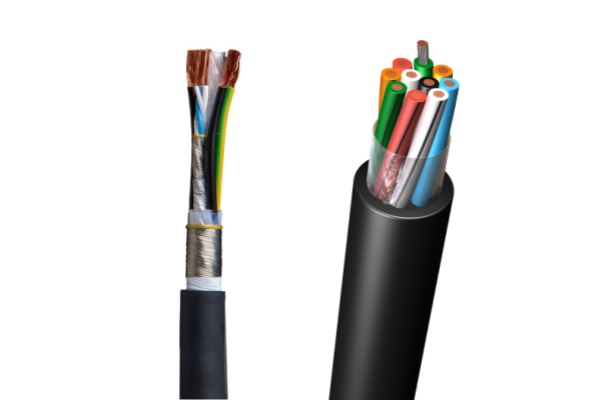

Хяналтын кабель нь үйлдвэрлэлийн хэрэглээний чухал бүрэлдэхүүн хэсэг юм, харилцаа холбоог хөнгөвчлөх, дохио дамжуулах, машин механизм ба автоматжуулалтын систем хоорондын хяналт. Эдгээр кабель байхгүй бол, орчин үеийн үйлдвэрүүд үр ашигтай, аюулгүй ажиллахгүй. Эдгээр мэргэшсэн кабелийг хамгийн бага хөндлөнгийн оролцоотойгоор цахилгаан дохиоллыг дамжуулахаар боловсруулсан болно, олон янзын орчинд нарийн үйл ажиллагааг хангах, Үйлдвэрийн шалнаас гадаа гаднах тохиргоонд хүрэх.
Энэ нийтлэлд, Veri кабель нь Аж үйлдвэрийн програмуудад ашигласан хяналтын кабелийг судлах болно, Тэдний загвар дээр анхаарлаа төвлөрүүл, материал, төрөл бүрийн төрөл нь хамгийн тохиромжтой орчинд байдаг. Өөр өөр төрлийг ойлгох замаар, Бизнес эрхлэгчид гүйцэтгэлийг оновчтой болгох талаар мэдээлэл өгөх боломжтой, Бага зэрэг буурах, аюулгүй байдлыг сайжруулах.


Хяналтын кабелийг хянах, тоног төхөөрөмжийг хянах, зохицуулахын тулд олон дамжуулагчийн кабелийг хийх зориулалттай олон дамжуулагч кабель юм. Эдгээр кабелийг ихэвчлэн автоматжуулалтад ашигладаг, үйлдвэрлэл, эрчим хүч, тээвэрлэлт, нарийвчлалтай хяналт нь зайлшгүй шаардлагатай бусад үйлдвэрүүд.
Тэд цахилгаан кабельээс ялгаатай, Энэ нь цахилгаан гүйдлийг авч явахад зориулагдсан болно, энэ нь тэд дохиоллын бүрэн бүтэн байдал, хамгийн бага хөндлөнгийн оролцоо. The тусгаарлагч, хяналтын кабелийг тусгаарлаж, хамгаалж байна тэдгээрийг доройтуулах, цахилгаан дуу чимээ гаргахгүйгээр дохиог дамжуулах нь чухал юм.
Одоо, Аж үйлдвэрийн програмуудад ихэвчлэн ашигладаг янз бүрийн хяналтын кабелийг судалж үзье:
Поливинил хлорид (PVC) Хэт их үр ашиг, өртөгтэй байдлаас болж хяналтын кабелийн хамгийн өргөн хэрэглэгддэг материалуудын нэг юм. PVC хяналтын кабелийг ихэвчлэн дунд зэргийн механик, химийн болон химийн хамгаалалт хийх үйлдвэрлэлийн хэсэгт ашигладаг.
PVC-ийн хяналтын кабель нь хуурай эсвэл бага зэргийн чийгтэй орчинд хамгийн үр дүнтэй бөгөөд хөнгөн механик стресс хэрэглээнд ашиглах боломжтой. Тэдгээрийг өргөн хэрэглэдэг, PVC Cables нь тос, химийн бодисуудад хязгаарлагдмал эсэргүүцэлтэй байдаг, зарим нь тодорхой харшилтай орчинд тохиромжгүй болгож магадгүй юм.
Полиуретан (ХЭДЭЭ) Хяналтын кабелийг хяналтгүй тэсвэр хатуужил, эсэргүүцлийн төлөө мэддэг, тос, болон химийн бодисууд. Цэвэр хяналтын кабель нь өндөр механик стресс, ширүүн орчныг тэсвэрлэх зорилготой юм, аж үйлдвэрийн өргөдлийг илүү их шаарддаг түгээмэл сонголт хийх.
Эдгээр кабель нь өндөр механик стресс хүлээж байгаа програмыг илүүд үздэг, жишээ нь чирэх гинж, Гар утасны автоматжуулалтын систем, болон Хатсан үйлдвэрлэлийн орчин.
Бамбай хяналтын кабелийг өндөр цахилгаан соронзон хөндлөн огтлолцол бүхий орчинд бүрэн бүтэн байдлыг хамгаалах зориулалттай (EMI) эсвэл радио давтамжийн хөндлөнгийн оролцоо (RFI). Эдгээр кабель нь хамгаалалтын давхарга өгдөг, Ихэвчлэн хөнгөн цагаан тугалган эсвэл зэс сүлжих шиг материалаар хийсэн, нь дохионы чимээ шуугиан, хөндлөнгийн оролцоог багасгахад тусалдаг.
Мэдрэмтгий хяналтын системүүд нь цахилгаан кабель эсвэл хүнд машин механизмын ойролцоо ажилладаг салбарт ажилладаг, Бамбай хяналтын кабель нь дохиоллын доройтол, системийн найдвартай байдлыг хангахад зайлшгүй шаардлагатай.
Багаж хэрэгслийн хяналтын кабелийг нарийвчлан, найдвартай дохиолол дамжуулах нь процессыг хянахад чухал ач холбогдолтой юм. Эдгээр кабелиуд нь хүчдэл багатай дохиогоор зохицуулах зориулалттай бөгөөд нарийвчлалтай, өгөгдлийн бүрэн бүтэн байдал нь чухал ач холбогдолтой салбаруудад ихэвчлэн ашигладаг, үлгэр жишээ, цахилгааны үе үе үе үе, болон эмийн үйлдвэрүүд.
Багаж хэрэгслийн кабелийг хяналтын системийн гөлгөр үйл ажиллагаагаа хянах нь чухал юм, ялангуяа зохицуулалтын шаардлага, мэдрэмтгий үйл явцтай салбарт.
Уян хатан хяналтын кабель нь динамик програмуудад ч бүрэн бүтэн байдлыг хангах зорилготой юм, тогтмол хөдөлгөөн эсвэл чичиргээ нь тохиолддог. Эдгээр кабелийг үйлдвэрүүдэд ашигладаг машин механизм нь байнга хөдөлгөөнтэй байдаг, автоматжуулалт гэх мэт, робот техник, ба материаллаг харьцах систем.
Эдгээр кабелийн уян хатан байдал нь тэдгээрийн уян хатан эд анги, дохиоллын алдагдалгүйгээр машин механизмд ашиглах боломжийг олгодог.
Халогенгүй хяналтын кабелийг галын хорт хий ялгаруулахад хорт хий ялгаруулах зориулалттай. Эдгээр кабель нь хлор шиг галогенгүйгээр хийгддэг, Баасандаа, эсвэл флюрин, шатсан үед хортой хий ялгаруулж чаддаг. Халоген үнэгүй кабелиуд нь галын аюулгүй байдлын стандартын стандартад нийцэж байгаа салбарт улам бүр чухал болж байна, Тээвэрлэлт гэх мэт, мэдээллийн төвүүд, болон арилжааны барилгууд.
Гал түймэрт аюулгүй байдал чухал ач холбогдолтой салбарт, Халоген үнэгүй хяналтын кабель тусламж онцгой байдлын үед хортой өртөх эрсдлийг багасгах.
Хувьсах давтамжийн хөтөч (Ягаан) кабель нь Controized Consectized Consectived Cover Covers ашигладаг. Эдгээр кабель нь цахилгаан дуу чимээ, хатуу түвшний өндөр түвшинг тэсвэрлэх зорилготой.
VFD Cables нь гөлгөр, үр дүнтэй моторын ажиллагааг баталгаажуулдаг, ялангуяа тусгай мотор хянах шаардлагатай үйлдвэрлэлийн програмуудад.
Тавиурын кабелийг тавиур дээр суурилуулах зориулалттай, нэхэмжлэл юм, болон аж үйлдвэрийн тохиргоонд суваг. Эдгээр кабелийг тэдний бат бөх байдлын төлөө мэддэг, Суулгахад хялбар байдал, янз бүрийн Цахилгаан, механик стрессийг зохицуулах чадвар.
Тавиурын кабелийг ашиглан машин механизм, автоматжуулалтын системийг ажиллуулахад шаардагдах үйлдвэрлэлийн үйлдвэрт ашиглагддаг.
Хуягласан хяналтын кабель нь өндөр механик хамгаалалт зайлшгүй шаардлагатай програмуудад зориулагдсан болно. Эдгээр кабель нэмэлт давхаргатай, ихэвчлэн ган утас эсвэл соронзон хальснаас гардаг, Энэ нь кабелийг гадны эвдрэлээс хамгаалдаг.
ХӨДӨЛМӨРИЙН ХЯНАЛТЫН КАТАСТАД ХАМГИЙН ХАМГИЙН ХАМГИЙН ХАМГААЛАХ БОЛОМЖТОЙ, Хүнд нөхцөлд ч гэсэн тасралтгүй үйл ажиллагааг хангах.
Хяналтын кабелийг Аж үйлдвэрийн системийн гөлгөр үйл ажиллагаа явуулдаг. PVC Хяналтын кабелиас Ачаалал, VFD CATERS-ээс АЖИЛЛАГААНЫ АЖИЛЛАГААНЫ АЖИЛЛАГААНЫ АЖИЛЛАГАА, төрөл бүр үйлдвэрлэлийн үйл явцыг оновчтой болгох тодорхой үүрэг гүйцэтгэдэг. Хяналтын кабелийн нийтлэг төрлийг ойлгох, тэдний програмууд, Түлхүүр шинж чанарууд нь салбарууд нь тодорхой хэрэгцээнд зориулж зөв кабелийг сонгоход тусалдаг, аюулгүй байдлыг сайжруулах, үр ашиг, болон үйл ажиллагааны даяар найдвартай байдал.
Өнөөгийн хурдан хурдтай үйлдвэрлэлийн орчинд, Зөв хяналтын кабелийг сонгох нь зөвхөн гүйцэтгэлийн тухай биш юм; Энэ нь боломжийн эрсдэлтэй холбоотойгоор ирээдүйн эрсдэлтэй холбоотой бөгөөд салбарын зохицуулалттай нийцэж буй байдлыг баталгаажуулах явдал юм. Зөв кабелиар, Үйлдвэрлэлүүд нь цаг хугацааг багасгах боломжтой, зардлыг бууруулах, ажилтнууд болон тоног төхөөрөмжийн аюулгүй байдлыг хангах.
Хүмүүс эрдэс бодисыг тусгаарлагдсан кабелийг сонсох үед, many immediately think of harsh environments like…
Харилцаа холбоо, цахилгаан дамжуулах системүүд хурдан ургадаг, the demand for reliable and cost-effective…
Том хэмжээний тос, хийн төслүүдэд, Аж үйлдвэрийн кабель нь зөвхөн дагалдах хэрэгсэл биш юм—they are the "nervous…
Цахилгаан холболтын ертөнцөд, кабелийн залгуур—кабелийн чих эсвэл кабелийн терминал гэж нэрлэдэг—байна…
Цахилгааны инженерийн төсөлд зөв резинэн кабель сонгохдоо, it is critical to…
Эрхэм хүндэт түншүүд, үйлчлүүлэгчид: 1-р сарын 29-ний өдөр, 2025 Хятадын Цагаан сарын баяр – Spring…